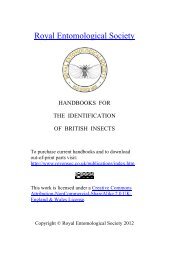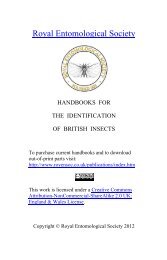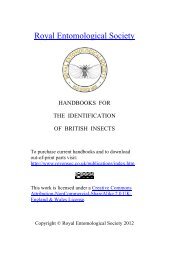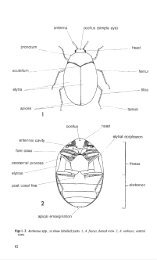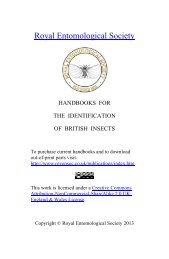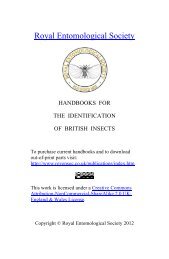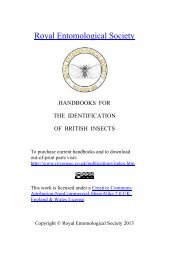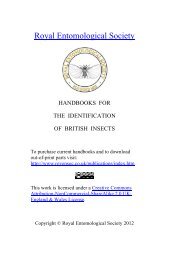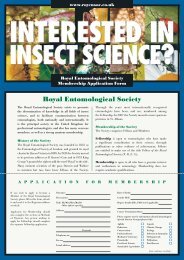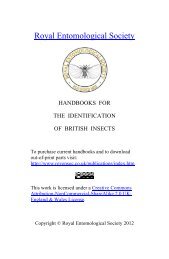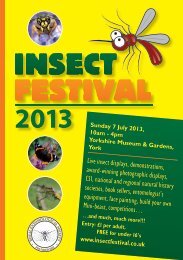Vol 10 Part 14. An introduction to the immature stages of British Flies ...
Vol 10 Part 14. An introduction to the immature stages of British Flies ...
Vol 10 Part 14. An introduction to the immature stages of British Flies ...
Create successful ePaper yourself
Turn your PDF publications into a flip-book with our unique Google optimized e-Paper software.
masses <strong>of</strong> Dixa (Dixidae) and larvae <strong>of</strong> Phaonia exoleta (Meigen) (Muscidae) feed on<br />
mosqui<strong>to</strong> (Culicidae) larvae.<br />
Some may also be attacked by adult Diptera, e.g. chironomid larvae are attacked by<br />
adult Dolichopodidae (Hydrophorus, Campsicnemus, Poecilobothrus and Dolichopus)<br />
(Smith & Empson, 1955). Simuliid larvae have been reported <strong>to</strong> be attacked by adult<br />
Empididae (Ciinocerinae and Hemerodromiinae) and Dolichopodidae in Canada<br />
(Davies, D . M., 1981).<br />
On plants, predaceous larvae <strong>of</strong> Les<strong>to</strong>diplosis are commonly found feeding on larvae<br />
<strong>of</strong> o<strong>the</strong>r Cecidomyiidae (Harris, 1966).<br />
In <strong>the</strong> U.S.A. water mites have been recorded as preda<strong>to</strong>rs on <strong>the</strong> eggs and larvae <strong>of</strong><br />
mosqui<strong>to</strong>es (Mullen, 1975).<br />
Parasites<br />
Parasites <strong>of</strong> Diptera should always be carefully preserved with all <strong>the</strong> relevant<br />
puparial fragments, etc. and data, as much remains <strong>to</strong> be discovered and many rea rings<br />
in <strong>the</strong> literature are in need <strong>of</strong> careful confirmation.<br />
The Hymenoptera provide <strong>the</strong> most important parasites <strong>of</strong> <strong>immature</strong> Diptera. A<br />
general survey is given by Shaw & Askew (in Stubbs & Chandler, 1978) and Smith<br />
(1974b). The principal parasites are as follows: Ichneumonidae (Phygadeuon (fig.<br />
1321), Mesoleptus and related genera on fly puparia, Oxy<strong>to</strong>rinae on Myce<strong>to</strong>philidae,<br />
Orthocentrinae on Diptera near <strong>the</strong> ground, Diplazontinae on aphidophagous<br />
Syrphidae): Braconidae (Opiinae on plant feeding Schizophora, Alysiinae (figs 1319,<br />
1320) on Cyclorrhapha); Eulophidae; Pteromalidae; some Ceraphron<strong>to</strong>idea; Proc<strong>to</strong>trupoidea<br />
(Piatygastridae on Cecidomyiidae); Diapriidae (Diapriinae on cyclorrhaphous<br />
puparia, Belytinae on Myce<strong>to</strong>philidae), Scelionidae, Trichogrammatidae,<br />
Mymaridae (all <strong>of</strong> <strong>the</strong> last three families are egg parasites on some Cecidomyiidae,<br />
Tabanidae, Rhagionidae and Syrphidae); Cynipoidea (Eucoilidae and Figitidae on<br />
Cyclorrhapha).<br />
In <strong>the</strong> Coleoptera some larvae <strong>of</strong> Staphylinidae, e.g. Aleochara, are parasites <strong>of</strong> fly<br />
puparia, mostly calypterates and especially <strong>An</strong>thomyiidae (see Welch, 1965). The<br />
species <strong>of</strong> fly parasitised probably varies with <strong>the</strong> habitat, e.g. Aleochara algarum<br />
Fauvel is parasitic on seaweed flies such as Coelopa and Orygma, while A. cur tu/a<br />
(Goeze) is a common parasite in <strong>the</strong> puparia <strong>of</strong> blowflies (figs 1322- 1326).<br />
Parasitism <strong>of</strong> Diptera by Diptera is not common and <strong>the</strong> few <strong>British</strong> records (see<br />
under family for details) may be summarised as follows:<br />
Tachinidae: Siphona on lea<strong>the</strong>rjacket larvae <strong>of</strong> Tipulidae and a Pegomya sp.;<br />
Admontia (Trichopareia) specialises in Tipulidae in wood, e.g. Ctenophora, Tipula<br />
irrorata Macquart and T.jlavolineata Meigen.<br />
Phoridae: Borophaga incrassata Meigen parasitizes larvae <strong>of</strong> Bibio marci L.; M egaselia<br />
paludosa Wood attacks lea<strong>the</strong>rjackets; M .jlavicoxa Zetterstedt parasitises larvae <strong>of</strong><br />
Bradysia bicolor Meigen (Sciaridae); and M. obscuripennis Wood is a parasite <strong>of</strong> larvae<br />
<strong>of</strong> Trichosia (Sciaridae).<br />
In <strong>the</strong> U .S.A. Macronychia (Sarcophagidae) has been reared from adult Tabanidae<br />
and some Tachinidae have been reared from larval and adult Tabanidae (Thompson,<br />
P. H ., 1978). In Australia a tachinid has been reared from an adult A<strong>the</strong>rigona (Muscidae)<br />
(Smith, 1974c, Ferrar, 1977).<br />
Parasitic fungi probably also take a steady <strong>to</strong>ll <strong>of</strong>larvae, as <strong>the</strong>y do <strong>of</strong> adults, though<br />
few are recorded specifically from Diptera larvae in <strong>the</strong> literature (Lea<strong>the</strong>rdale, 1970).<br />
I have found <strong>the</strong> larvae <strong>of</strong> Lonchaea palposa Zetterstedt infested with <strong>the</strong> 'green<br />
muscardine' fungus Metarrhizium anisopliae (Metsch) (Smith, 1957b). D'Arcy-Burt<br />
( 1987) reports <strong>the</strong> hyphomycete Tolypocaladium cylindrosporum Gams from <strong>the</strong> larvae<br />
<strong>of</strong> Bibionidae. Abroad, but not yet in Britain, species <strong>of</strong> Coelomomyces fungi have been<br />
found in <strong>the</strong> larvae <strong>of</strong> mosqui<strong>to</strong>es.<br />
20




